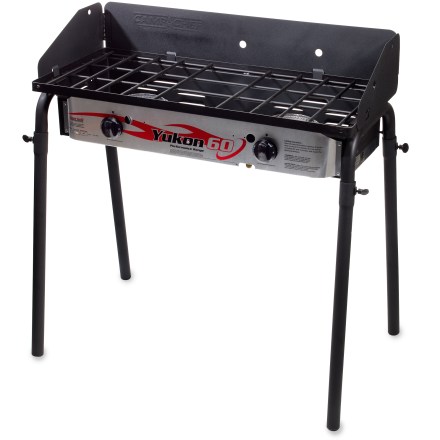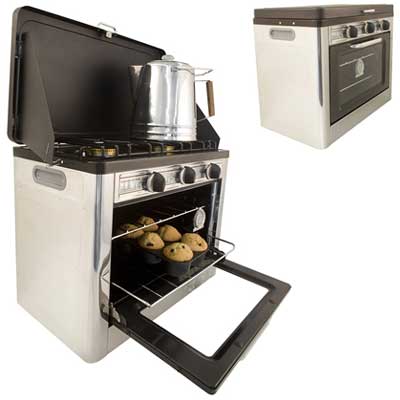There are many ways to cook in camp, a stove is just one of the ways. I was recently reading on a forum about a Troop that does not allow stoves, all cooking has to be done using charcoal. The only problem with this, there are many parts of the country where you are not allowed any kind of “open flame”. For example the mountain near the city I live in six months out of the year fires, charcoal, white gas stoves, even smoking is prohibited do to the fire danger. Ok smoking is allowed but only in your own car. The point is many of us don't have the option of cooking of a wood or charcoal fire year around, that means we have to use stoves.
In the picture above you can I have laid out several examples. I will briefly explain each. The one on the left has a grill on one side and a small burner on the other side. Personally I don't like this stove as I find the burner to small for my cast iron frying pan. However for most patrols it would probably be just fine. On the right is the standard 2 burner Coleman stove that I bet all of us have used. Both of these stoves use propane. The three stoves in the center of the picture are examples of light weight backpacking stoves. In this case all two use white gas and one propane.
In the below pictures you will see a larger camp chef style stove and a camp oven. I actually have a stove similar to the one shown, but didn't get a chance to take a good picture of it. I like using it when cooking for large groups, or if I am doing a more complex camp meal for the adults. I have been known to do things like beef soup from scratch, and slow cooked rump roast while camping. I added the picture of the oven just to give you an idea that other gadgets do exist and some of are cool, but often times unpractical for a weekend camp. Just because we can and it exist does not always mean we should.


Now lets talk about fuels for a moment. Each type of gas has good and bad points I will not say one is better then the other. One thing you need to be aware of that Boy Scouts of America does have specific rules and guidelines you need to follow when working with fuels. I will not outline them here as they could change, instead refer to a copy of Guide to Safe Scouting.
For example when I was a Scout on my first backpacking trip the Troop what brupane based backpacking stoves. The temperature dropped below freezing and the gas froze, we were unable to cook breakfast. One of our leaders had to get creative to get our stoves working. He did this using his white gas stove and a pot of water. Needless to say I will not provide any instructions or details on what he did exactly. The lesson we learned was white gas had a far lower freezing point and thus worked better in that particular climate at that particular time. The stoves we were using we called "blue-its" and learned after this trip in cold environments we had to sleep with the gas to keep it from freezing. As a result the Troop replaced them with nice Peak 1 white gas stoves. In the top picture the small green stove with the greyish square pot on it kind of looks like a Peak 1 stove.
Propane is a very easy fuel to use. All you have to do is get a small green can, screw it on, light it, and way you go. Because propane is already under pressure you do not have to pump it or do anything special. Propane has to be under pressure because its boiling point (point when it turns from a liquid to a gas) is negative 44 degrees Fahrenheit. This means that it is normally a gas. In order to turn it into a liquid you need to pressurize it, which is why it is stored in strong metal containers.
With white gas (Coleman fuel) you have to pump the container up, heat up a bit of the fuel, and then ignite it. So it obviously takes more time to set up and start a white gas stove then it does for a propane stove.
Another benefit to propane gas is it is easy to handle the transport. You do not have to worry about filling it up, spilling fuel, or priming it. This makes it the idea fuel source for individuals new to the outdoor/camping experience.
One of the problems is you cannot use propane in very low temperatures. If it is just 40 degrees then you should have much of a problem. But if you plan on camping in the snow or where it is 0 degrees then you need another fuel source like white gas. White gas does not have this issue.
More important than extra weight (in my opinion) is that you cannot refill the small propane canisters. Instead you are forced to trash them into a landfill. With white gas stoves you just refill the container.
Propane has another issue when it comes to cooking. When propane burns it produces heat, light, carbon dioxide, and water. So the water vapor will come in contact with your food and does effect how it is cooked ever so slightly. This is why some snobbish chef’s (like on Iron Chef) refuse to cook with the gas in the stadium and instead us charcoal or another dry fuel source. This is also one of the reasons why I like to use charcoal to cook instead of propane, the other is briquettes also impart a nice flavor.
One of the nice features about some white gas stoves is many of them can use alternative fuel sources. This is nice if you are in a country that doesn’t sell propane then you can easily use their fuel sources. But keep in mind that not all stoves have this as an option and many other forms of fuel do not burn as cleanly as propane. Every propane stove I know of only burns propane.
Most of the above section that explains the differences between propane and white gas comes from this page http://www.epinions.com/content_4659912836, but I agree with the original author.
Overall in Scouting most of us will go with propane just because its easier, more convenient, and in many Scouters minds safer (thought I don't fully agree as its like anything its about hows its used and handled).
Please add your thoughts, comments, ideas, concerns, etc in the comment section below. I would love to hear from you.
